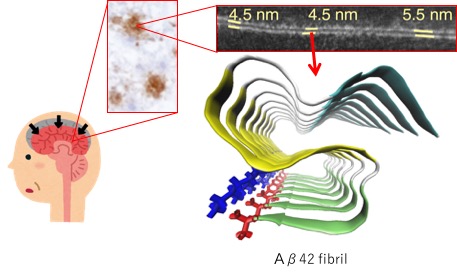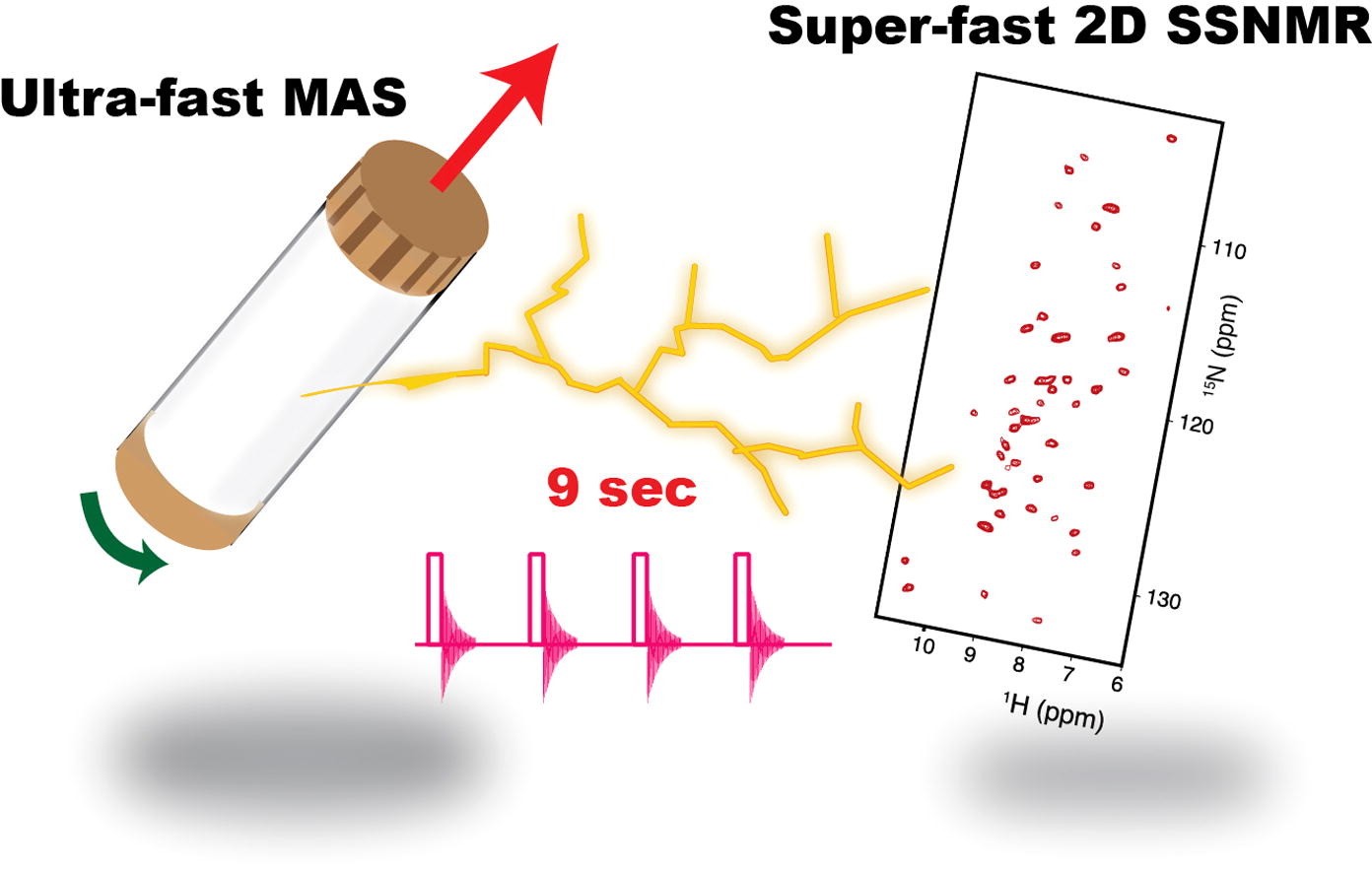The Ishii laboratory aim to reveal mysteries of life phenomena as well as advanced materials
by elucidating atomic-level structures of biological molecules and nano-materials with solid-state NMR (SSNMR) spectroscopy.
One of our major recent interest is Alzheimer’s disease (AD), which currently has no cures.
We focus on structural analyses of amyloid proteins, which are believed to trigger AD, Parkinson’s,
and other fatal neurodegenerative diseases, at molecular level to seek a clue for effective cures.
Our SSNMR skills are also at a world-leading level.
We believe that it is exciting and worthwhile to develop novel SSNMR methodologies
that would reveal intricate mechanisms of the nature no one have ever observed.
The research in our lab is cross-disciplinary.
Namely, our students and staff members with varied and overlapping interest in physical chemistry
and computer science as well as in biology and biochemistry work together.
We value our lab culture where you can explore your curiosity in the lab with “joy of science”.
The Ishii lab actively advances collaborative researches with RIKEN and other renowned laboratories overseas.
Students are trained to present their seminars in English at the lab for international collaborations.
1. Elucidation of pathogenic process of Alzheimer’s disease
One of our main targets is amyloid-β proteins (Aβ), which has been a major suspect of Alzheimer disease. Although an Aβ molecule is harmless in a monomeric form, aggregation of many Aβ monomers into fibrillar or spherical oligomer forms (misfolding of Aβ) are known to induce neurotoxicity. In our laboratory, we analyze the structures of the aggregates and find out this “misfolding” processes1,2. For example, we have elucidated the first structure of amyloid fibrils for misfolded 42-residue Aβ (Aβ42), by SSNMR in the world.2 In our ongoing research, we focus on the Aβ structures from patients’ brain and interaction between Aβ and antibody or small molecules as prospective drugs. Besides SSNMR, we actively utilize electron microscopy and other analytical methods with various biochemical methods to reveal the mystery of AD in the project.
1. Nat. Struct. Mol. Biol., 14, 1157-1164 (2007).
2. Nat. Struct. Mol. Biol., 22, 499-505 (2015).
Ishii Laboratory
School of Life Science and Technology,
Tokyo Institute of Technology
Research

2. Enhancement of sensitivity and resolution in solid-state NMR
SSNMR is a powerful tool for structural analysis particularly on samples like amyloid proteins, which are insoluble and difficult to form single crystals. However, limited sensitivity in SSNMR had long been a bottleneck for biological applications. So far, we have succeeded in the drastic enhancement both in sensitivity and resolution of SSNMR by developing a series of novel measurement schemes3 and combining them. This new approach enables SSNMR measurements of as little as nano-molar (nmol) order of a protein sample, which corresponds to 1/100–1/1000 of the conventional sample requirements for SSNMR. We are also pursuing a future-oriented NMR methodology such as analyses of biological samples from cells and living bodies, a combination of cryo-electron microscopy and SSNMR, and super-fast multidimensional SSNMR measurements4.
3. Nature Methods 6(3), 215-218 (2009).
4. J. Magn. Reson. 286, 99-109 (2018).
SSNMR is a powerful tool for structural analysis particularly on samples like amyloid proteins, which are insoluble and difficult to form single crystals. However, limited sensitivity in SSNMR had long been a bottleneck for biological applications. So far, we have succeeded in the drastic enhancement both in sensitivity and resolution of SSNMR by developing a series of novel measurement schemes3 and combining them. This new approach enables SSNMR measurements of as little as nano-molar (nmol) order of a protein sample, which corresponds to 1/100–1/1000 of the conventional sample requirements for SSNMR. We are also pursuing a future-oriented NMR methodology such as analyses of biological samples from cells and living bodies, a combination of cryo-electron microscopy and SSNMR, and super-fast multidimensional SSNMR measurements4.
3. Nature Methods 6(3), 215-218 (2009).
4. J. Magn. Reson. 286, 99-109 (2018).

3. Structural analysis of nanomaterials
Solid-state NMR spectroscopy is applicable to a variety of materials as well as biological molecules. In our laboratory, we also analyze structures of nanomaterials such as graphene derivatives. For example, the structures of graphene oxide (GO) or chemically modified GO have been difficult to analyze by electron microscopy because of their structural heterogeneity. By SSNMR combined with ab initio chemical shift calculation, we can approach the structure5,6. In addition, inorganic elements like lithium and aluminum are also observable by NMR. Thus, solid-state NMR is effective for structural analyses of inorganic materials such as battery materials, which are hardly accessible by other spectroscopies.
5. Science 321, 1815-1817 (2008).
6. J. Am. Chem. Soc. 132(16), 5672-5676 (2010).
Solid-state NMR spectroscopy is applicable to a variety of materials as well as biological molecules. In our laboratory, we also analyze structures of nanomaterials such as graphene derivatives. For example, the structures of graphene oxide (GO) or chemically modified GO have been difficult to analyze by electron microscopy because of their structural heterogeneity. By SSNMR combined with ab initio chemical shift calculation, we can approach the structure5,6. In addition, inorganic elements like lithium and aluminum are also observable by NMR. Thus, solid-state NMR is effective for structural analyses of inorganic materials such as battery materials, which are hardly accessible by other spectroscopies.
5. Science 321, 1815-1817 (2008).
6. J. Am. Chem. Soc. 132(16), 5672-5676 (2010).

Back to Home Page Top